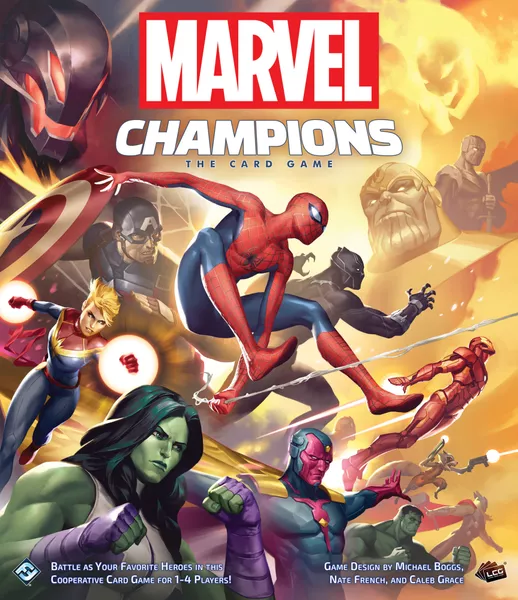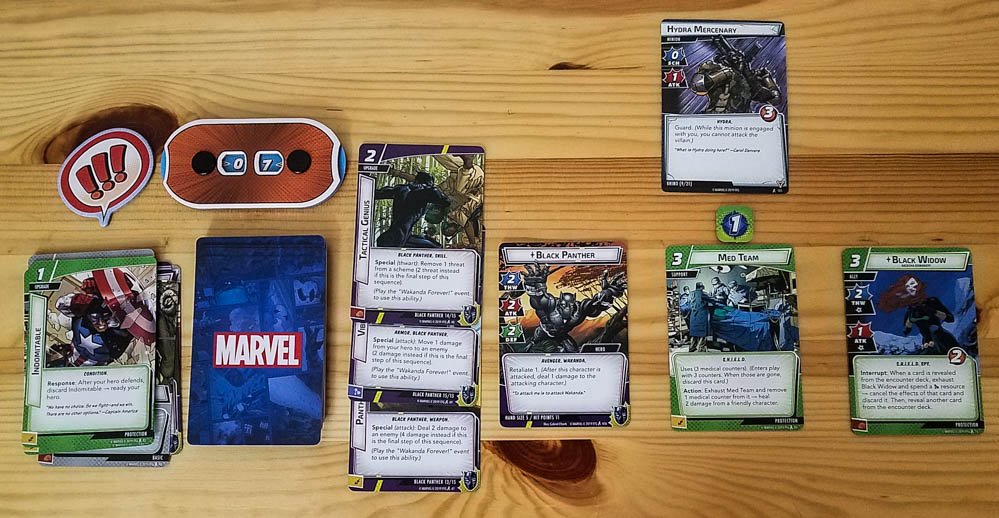Marvel Champions Review
Year: 2019 | Players: 1-4 | Minutes: 45+ | Ages: 14+
This Marvel Champions review was made after playing the game 9 times.
What is Marvel Champions LCG?
Marvel Champions is a cooperative card game in which you play as Marvel superheroes who are attempting to thwart villains’ evil schemes.
This is the third cooperative Living Card Game (LCG) that Fantasy Flight has released following The Lord of the Rings: The Card Game and Arkham Horror: The Card Game, which means that new content will be released for it every month.
Marvel Champions was designed by Michael Boggs, Nate French, and Caleb Grace.
Rules Overview
Your goal in Marvel Champions is to defeat the villain you’re facing before they’re able to complete their scheme. The heroes included in the core box are Spiderman, She-Hulk, Captain Marvel, Iron Man, and Black Panther. The villains included are Rhino, Klaw, and Ultron.
Each hero has an identity card that has a hero side and an alter-ego side, which affects your hand size, the cards you can play, and how the enemies will act. A hero’s deck consists of 15 unique cards, some cards from one aspect set (Aggression, Justice, Leadership, or Protection), and some basic cards.
There are suggestions in the rulebook for how to create each hero’s deck, but once you’re comfortable with the game you can choose any cards from one aspect set and any basic cards as long as you end up with 40-50 cards. Each hero also has an Obligation card that goes into the villain’s encounter deck and a set of nemesis cards that could enter the game at some point if a certain card is drawn from the encounter deck.
A villain’s main deck is just multiple versions of that villain (for example, Klaw I and Klaw II); you need to defeat every card in that deck to win. The encounter deck consists of the villain’s unique encounter set, the standard encounter set, and a modular encounter set.
There is a suggested modular encounter set for each villain, but you can use any of them (there are five in the core box). The villains also have their own scheme decks and their goal is to complete their schemes by adding a certain amount of threat to them.
Each round has a Player Phase and a Villain Phase. During the Player Phase each player will use their cards to get stronger, fight the enemies, and to thwart the villain’s schemes. During the Villain Phase the enemies will attack all of the heroes that are in hero form and they’ll add threat to their scheme for every hero in alter-ego form.
Once per turn, you can switch from your hero form to your alter-ego form or vice versa. When you’re in hero form your hero can attack the enemies, thwart any active schemes, and defend attacks. When you’re in alter-ego form, you can recover health and you’ll be able to draw more cards at the end of your turn. Some cards can only be used when you’re in a specific form.
There are five different types of player cards in the game: ally cards, upgrade cards, support cards, event cards, and resource cards. When you want to play a card, you pay for it by discarding other cards in your hand for their resource values. For example, if you’re playing as Iron Man and you want to play the War Machine ally card, which costs four resources, you have to discard other cards until you’ve totaled four resources. Any card that has the word “Action” on it can be used during any player’s turn, so you could pay for a card from your hand to help out a teammate during their turn. After everyone has taken a turn, you discard any cards that you don’t want, draw up to your current hand size based on your form, and then ready any heroes and allies that were exhausted during the turn.
The villain activates once per player and any minions in front of the heroes also activate. For each villain activation, you’ll draw an encounter card just for its boost value, which adds to the villain’s attack or scheme value. Whenever an enemy attacks, any readied hero or ally can choose to defend (before the boost card is revealed). After that, each player draws and resolves an encounter card, which could be a minion, an attachment for the villain, a side scheme, or some other type of negative effect. This is also when you could draw your Obligation card or the card that brings a hero’s nemesis into play.
You’ll win if you defeat the villain. You’ll lose if the villain completes their scheme or all heroes are defeated.
For more info on how the game plays, check out the Marvel Champions rulebook (PDF).
Pros and Cons
Pros
- The heroes in Marvel Champions all play differently and they feel like themselves thanks to the 15 unique cards that each one has. You have to switch up your strategy based on the heroes that you pick and the villains that you face each game, which is great.
- I really like the dual-use cards. You want to play just about every card you draw, but you have to give some of them up to pay for the ones that you need the most each turn. That makes each decision feel like it really matters… because it does.
- The alter-ego/hero mechanic is very cool. I like that it affects the actions that you can perform and your hand size. Plus, you can pull off some pretty cool combos where you use cards that take advantage of the alter-ego’s ability and then switch to hero form and do some damage. It also gives you some control over how the enemies act each round, which works thematically.
- There are plenty of good cooperative decisions and actions. Not only do you need to talk about how you’re going to attack and/or thwart, you also need to figure out how you’re going to defend the enemies’ attacks during the second half of the round. It’s just a ton of fun trying to figure out how to take advantage of each hero’s strengths while also trying to make up for their weaknesses. It’s a constant cooperative balancing act.
- It’s surprisingly simple to customize the hero decks. Just pick an aspect and add some of those cards, then add in some basic cards. Sure, it’ll get more complicated once there are hundreds of cards to choose from, but I don’t think it’ll ever be overwhelming. If you’re worried about the deck customization part of this game, just know that all of the villains in the core box are beatable with the starter decks.
- Marvel Champions is extremely easy to get into. I taught two new gamers how to play by using the recommended Rhino setup and they pretty much had it down after a few rounds.
- It’s also very easy to adjust the difficulty. If you want Rhino to be tougher, use the Rhino II and Rhino III cards instead of I and II, and/or you can just shuffle in a more difficult modular encounter set.
Cons
- Analysis paralysis can be an issue for some people while playing Marvel Champions. That’s the downside of a game that gives you so many options every turn. You could have six or seven cards in your hand and you’ll need to figure out which cards are best for you and your team while also knowing what your teammates’ plans are. It’s a lot to think about and pay attention to, especially during your first couple of games with a new hero.
- It kind of stinks that there aren’t enough cards in the core set to run two or more heroes with the same aspects. That’s unfortunate because you might want to have, say, two Aggressive or two Justice heroes on your team and you just can’t.
- Ultron is fun to face, but I don’t like that the heroes’ cards are used to represent his drones. It doesn’t make sense thematically and the fact that you have to discard the card after you defeat the drone means that you could be discarding a valuable card.
Final Thoughts
Marvel Champions is a fantastic cooperative card game. I’m not even a huge Marvel fan and I’ve enjoyed this one a lot, and so have the six people I’ve taught it to. Figuring out how to use the different heroes each game and then tweaking the decks a bit to face the expert-level villains has been a blast.
I’ve played Marvel Champions at every player count now and I think it’s best at two and three players. You get a good mix of hero skills to balance out your team at those counts and the games never feel too long (though some three-player games can run pretty long). Four-player games are still fun, but they can take 2+ hours and there seems to be quite a bit more downtime. Solo is good, too, but this one just feels like it should be played co-op.
I don’t see any Marvel fan disliking this game. Even if you’re not a Marvel fan, I’d still check this one out if you’re looking for a good 2-3 player card game. I’d even recommend this to people who don’t like the LCG model since there is plenty of replay value in the core box and, if you decide later on that you want a new hero or villain, you can just buy it and be good to go.
Marvel Champions exceeded my expectations and it should only get better with future hero and scenario packs. I don’t like it quite as much as The Lord of the Rings: The Card Game (one of my top two-player cooperative games), but that’s because I like that theme more and I like that it has a true adventure game feel. I sure am happy that I now own both of them, though!
- Update: Marvel Champions is #1 on the Best Cooperative Board Games of 2019 list!
- Update 2: It also made it onto the Best Cooperative Board Games Ever list!
Marvel Champions Links
BGG | Amazon | Miniature Market
Thanks for taking the time to read our Marvel Champions review!
Be sure to also take a look at our Best Cooperative Board Games list and other rankings.
Subscribe to our newsletter if you want more co-op board game content sent right to your inbox!




